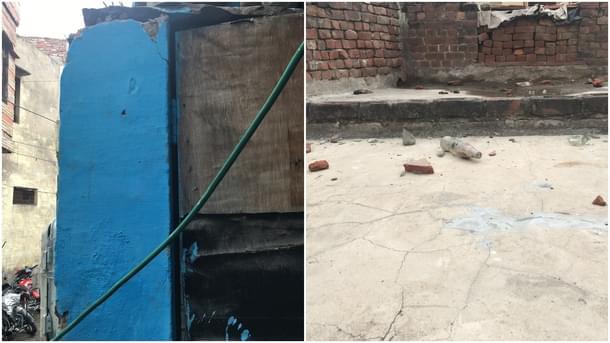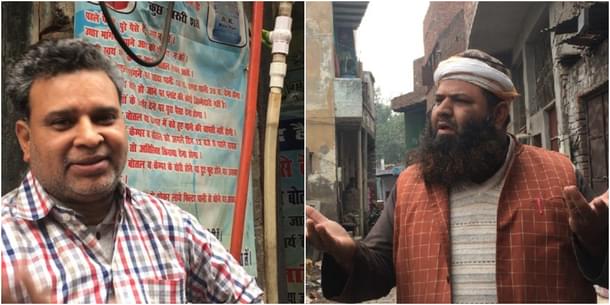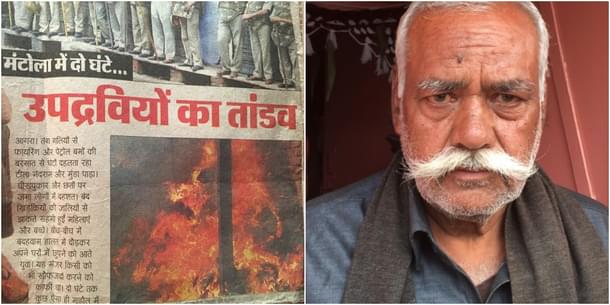Politics
Ground Report: Why The Latest Communal Clash In Agra’s Mantola Could Further Drive Hindus Out
Swati Goel Sharma
Feb 08, 2019, 04:35 PM | Updated 04:35 PM IST
Save & read from anywhere!
Bookmark stories for easy access on any device or the Swarajya app.
What happened in Agra's Mantola locality this week is what is commonly described as a 'petty' communal clash.
After a Dalit Hindu man was pushed by a group of Muslim men, the two sides indulged in stone-pelting. The Muslim side allegedly threw glass bottles filled with acid and opened fire. No casualty was reported but several people from the Hindu side were injured and hospitalised.
Still, as communal clashes in Uttar Pradesh go, it was a petty incident.
Except that this was an addition to a series of violent communal clashes in the locality and could trigger another round of migration by Hindu families. Mantola has never made headlines the way Kairana has, but Hindu organisations and locals have long been raising concerns of "Hindu exodus" from this Muslim-majority locality.
What happened on Sunday
Less than five kilometres from the Taj Mahal, the congested Mantola locality in south Agra is marked by rows and rows of shoe factories and workshops and retail units. Most factories are owned by Muslims while the labour comprise mostly of Dalit Hindus.
The Mantola police call it a communally-sensitive area as it flares up frequently.
An everyday issue here, however, is non-availability of clean drinking water given the large number of factories and illegal slaughterhouses that have polluted ground water. Hindu residents of Teela Nandgram colony depend on an RO (reverse osmosis) plant in the adjoining Munda Pada colony that is inhabited by Muslims.
On 3 February (Sunday) around 8 pm, Pramod Kumar was returning after fetching water from the RO plant when a group of Muslim men caused him to trip and fall.
"They did it intentionally. They always stand in groups and tease us whenever we go into their colony," Kumar, who works in a shoe factory, told Swarajya.
Pramod said he fell down, wounded his head and and let out some expletives. He then returned home (hardly 20 metres from the spot) and asked his elder brothers Arun and Anil to accompany him to confront the group.
As per the brothers, the Muslim group had by then been joined by scores of fellow community members who launched an attack on their houses. "They started throwing stones and bricks and even fired gunshots. They threw bottles filled with acid from their terrace," said Arun.
Three houses in a row, all belonging to the brothers, were attacked. When Swarajya visited the site on Wednesday (6 February), they showed us the bullet marks on the walls, and glass bottles that were still lying on their terrace.
“We scurried inside our houses. Some of us went to our neighbours’ to hide and save our lives,” Arun’s sister said.
Arun is left with a fractured foot, while his 62-year-old aunt Chandra Devi is recovering in a hospital in New Delhi.
Chandra Devi's husband Premchand told Swarajya, "A heavy brick hit her on the chest. Our son Vinod also sustained a fracture while trying to save his mother. I sent them to Delhi."
Pramesh Singh Maurya, a relative of Premchand, said he called up the police who arrived in about half-an-hour. "By then, 12 of our people had been injured, including a three-year-old child.”
The victims, however, did not file a police case. Pramod said they were too busy getting treated for their injuries.
Sub-inspector Veer Singh Yadav filed a first information report (FIR) and booked 50-60 unidentified men under sections 147, 148, 149, 307, 336, 504 of IPC and 7 of Criminal Law Amendment Act. The FIR (accessed by Swarajya) says the police recovered two bullets, .315 bore, two cartridges and shards of glass from the spot.
Until Wednesday, the police had not made any arrests. "Investigation is on. So far, about 25 names have come to light,” sub-inspector Chandra Shekhar Gautam from Mantola police station told Swarajya.

Some reports had said that the Hindu side also grouped and indulged in pelting stones on the other side. The victims, however, deny this. "We acted only in self-defence. How could unarmed people like us fight those with pistols and bullets?" said Pramod.
Pramod identified the alleged attackers with names but refused to take this correspondent to their houses. Arun said he was scared that the police might pick them up as accused based on "false statement by the other side". "Our sister's wedding is in April. Who will do the preparations if they come after us?" he said.
The "other side", that is the residents of the Mulla Pada colony, did not speak much on the matter when Swarajya approached them.
Aakil Qureshi, who owns the RO plant, said he did not witness the incident but was sure that no gunshots had been fired. Mohammad Shamyuddin, an electrician, said that most residents had gone to a kabristan as a five-year-old girl in the colony had passed away, and thus there were hardly any witnesses. Haji Yusuf, a resident, said that Pramod might have been drunk and tripped on his own. Haji Sanu, who owns a shoe factory, said that such incidents keep happening in the area as "people are often drunk and abuse each other”. He said that bottles and bricks are thrown from both sides in such clashes.

The residents said they did not know the names of the accused as alleged by Pramod and Arun.
Qureshi added, "It was a petty incident. We all live peacefully here."
"They Want To Drive Us Out"
The Hindu side deny it was a petty incident. "They fired bullets at us so their intention was obviously to kill," said Pramesh Singh.
The Hindus, most of them from the Jaatav caste, said the Sunday violence was essentially a "palayan ka maamla" ("a case of exodus").
For several years now, the Hindu residents have been saying that they are being driven out "in a systematic way" by their wealthy and powerful Muslim neighbours. In 2016, over 60 Hindu residents protested outside the district magistrate’s office alleging that Muslims are constantly harassing Hindus in a bid to “take over” the area.
As per Rajesh Chowdhary, a resident, there were about 400 Hindu families in the locality some 20 years ago that have now reduced to just about 100, who now live amid some 500 Muslim families. "In 20 years, at least 14-15 clashes have happened. Hindus bear the brunt so we just keep migrating out after selling our houses to Muslims," he said.
In the 2016 protest, the residents even demanded that no Hindu house should be sold to a Muslim family without the DM’s approval.
A year before the protest, a local Bajrang Dal leader was gunned down, causing communal tension. Arun Mahor was a Dalit Hindu who had shifted out of this locality some years earlier. After the gruesome killing, the Vishwa Hindu Parishad and Bajrang Dal handed a list to the police of families who they claimed had migrated out of fear of Muslim community.
“Violence is a strategy to drive us out. Else why would they open fire over such a petty issue?" asked Pramesh. "It's because they want to take over this entire locality,” he said.
The residents have expressed this fear before, and now they are expressing it again.
Poonam Devi, a resident, said that two of his three sons have left the colony after repeated violence. She said that residents of Mulla Pada insult them using casteist slurs and harass girls who pass by their colony to reach school. “They are rich and we are poor. So they easily dominate us,” another woman said.
"The Hindu families have been continuously leaving since Basheer kaand," Chowdhary said.
In October 2003, Mantola saw one of its bloodiest clashes involving local politician Choudhry Basheer. After he deflected from Bahujan Samaj Party to Samajwadi party, supporters of both sides clashed and Mantola burnt for several days. Hindus found themselves to be at the receiving end of the indiscriminate stone-pelting and firing.
Residents said most victim families have moved out. A woman told Swarajya that her son was fired at when he was at home and even after so many years, he has not fully recovered.
Clashes also occurred in 2015 after pieces of meat were thrown at a Ganpati procession, and in 2017 when a Muslim man named Nasir beat up a Hindu man named Dheeraj.
Hindus say they live in fear. In 2014, when an alleged 'ghar wapsi' of around 60 Muslims was reported from an Agra slum, Muslims leaders gathered in Mantola and delivered inflammatory speeches, threatening large-scale violence.

Shivcharan lives in the colony connecting Teela Nandgram to the main road. His house was set on fire in 2011 by a Muslim mob over what he says was a petty dispute. Shivcharan had beaten up a Muslim bike rider after he was hit by his vehicle (read the 2011 report here).
"A man named Saliuddin Qureshi, who had nothing to do with the dispute, stood here and asked the crowd to burn down my house. I am still fighting the case in court," he told Swarajya bitterly.
Shivcharan says his house was targetted without any provocation with the sole motive of driving him out. "We are the only two Hindu families in this colony. The Muslims want us out so that this entire colony become theirs. As you can see, a large mosque is coming up at the exit," he said. "They have been doing everything from offering us money to putting all kinds of pressures.”
Shivcharan said he does not want to leave. Residents of Teela Nadgram don't want him gone either.
"If Shivcharan leaves, we'll be surrounded by Muslim colonies on all three sides. And then, we will have no option but to leave too,” said Arun.
A closer look at the situation in Mantola throws up a case study in changing demographics of an area. It also shows that what we commonly understand of majority-minority equations for the country as a whole may not be true for individual states, villages and even tiny localities.
In Mantola, the minority Hindus - who otherwise form the majority in India - lack in resources and live in fear.
Swati Goel Sharma is a senior editor at Swarajya. She tweets at @swati_gs.





